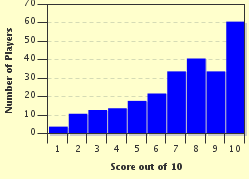Quiz Answer Key and Fun Facts
1. Turner is usually referred to by his third name of William. What do the other initials in his name stand for?
2. Turner was born in which area of London, which is now associated with another field of the arts?
3. Turner is usually classed as belonging to which artistic movement?
4. Turner's painting 'The Fighting Temeraire' depicts which type of transport?
5. Which fellow artist described Turner in these words: 'he seems to paint with tinted steam, so evanescent and so airy'?
6. Before devoting his life to art, Turner considered making a career in which other field?
7. By the 1840s Turner had fallen out of favour, but was defended by which art critic in his book 'Modern Painters'?
8. First exhibited in 1844 is a painting by Turner of a train. The 'subtitle' is 'The Great Western Railway', but how is it better known?
9. On his death, Turner left his paintings and drawings to which of these?
10. Turner died in 1851 and is buried in which of these places?
Source: Author
rossian
This quiz was reviewed by FunTrivia editor
Snowman before going online.
Any errors found in FunTrivia content are routinely corrected through our feedback system.

